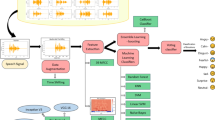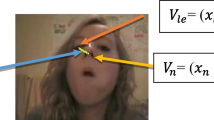Abstract
Emotions can be expressed through language, facial expressions, voice, and other means. However, facial expressions and voice can be hidden or distorted by an individual's will. However, language has less distortion of emotions due to the situation and linguistic meaning. Therefore, in this paper, we propose a Korean emotion analysis system using only linguistic expressions. The proposed system considers the emotional elements of words. The emotion word dictionary considered the characteristics of the Korean language by using FastText, which learns subwords using n-grams. The proposed system proposes a deep learning module learned through KoBERT Fine-tuning and a sentiment analysis module through machine learning ensemble machine learning for sentiment analysis. This paper improves the accuracy of the Korean emotion analysis system by combining deep learning modules and machine learning modules.
Access this chapter
Tax calculation will be finalised at checkout
Purchases are for personal use only
Similar content being viewed by others
References
Dawel, A., et al.: Perceived emotion genuineness: normative ratings for popular facial expression stimuli and the development of perceived-as-genuine and perceived-as-fake sets. Beh. Res. Meth. 49, 1539–1562 (2017)
Devlin, J., et al.: Bert: pre-training of deep bidirectional transformers for language understanding. arXiv preprint arXiv:1810.04805 (2018)
Santos, I., Nedjah, N., de Macedo Mourelle, L.: Sentiment analysis using convolutional neural network with fastText embeddings. In: 2017 IEEE Latin American Conference on Computational Intelligence (LA-CCI). IEEE (2017)
Gao, X., et al.: An adaptive ensemble machine learning model for intrusion detection. IEEE Access 7, 82512–82521 (2019)
Wang, R., Li, J.: Bayes test of precision, recall, and F1 measure for comparison of two natural language processing models. In: Proceedings of the 57th Annual Meeting of the Association for Computational Linguistics (2019)
Baek, C., Kang, J., Choi, S.: Online unstructured data analysis models with KoBERT and Word2vec: a study on sentiment analysis of public opinion in Korean. Int. J. Fuzzy Logic Intell. Syst. 23(3), 244–258 (2023)
Bojanowski, P., et al.: Enriching word vectors with subword information. Trans. Assoc. Comput. Linguist. 5, 135–146 (2017)
Thavareesan, S., Mahesan, S.: Sentiment lexicon expansion using Word2vec and fastText for sentiment prediction in Tamil texts. In: 2020 Moratuwa Engineering Research Conference (MERCon), Moratuwa, Sri Lanka, 2020, pp. 272–276 (2020). https://doi.org/10.1109/MERCon50084.2020.9185369
Han, J., Micheline, K.: Data Mining Concepts and Techniques. Morgan KaufmMLP (2001)
Dong, X., Yu, K., Cui, Z.: Readmission prediction of diabetic patients based on AdaBoost-RandomForest mixed model. In: 2022 3rd International Conference on Big Data, Artificial Intelligence and Internet of Things Engineering (ICBAIE), Xi’an, China, 2022, pp. 130–134 (2022). https://doi.org/10.1109/ICBAIE56435.2022.9985819
Lee, S., et al.: Kr-Bert: a small-scale Korean-specific language model. arXiv preprint arXiv:2008.03979 (2020)
This research (paper) used datasets from ‘The Open AI Dataset Project (AI-Hub, S. Korea)’. All data information can be accessed through ‘AI-Hub (www.aihub.or.kr) Min, Moohong, Jemin J. Lee, and Kyungho Lee. “Detecting illegal online gambling (IOG) services in the mobile environment.“ Security and Communication Networks 2022 (2022)
Datta, L.: A survey on activation functions and their relation with xavier and he normal initialization. arXiv preprint arXiv:2004.06632 (2020)
Cho, J., Jung, H., Park, C., Kim, Y.: An autonomous assessment of a short essay answer by using the BLEU. In: Korean HCI Conference 2009, vol. 2, pp. 606–610 (2009)
Acknowledgments
This work was supported by the Ministry of Education of the Republic of Korea and the National Research Foundation of Korea (NRF-2022S1A5C2A07091326).
Author information
Authors and Affiliations
Corresponding author
Editor information
Editors and Affiliations
Rights and permissions
Copyright information
© 2024 The Author(s), under exclusive license to Springer Nature Switzerland AG
About this paper
Cite this paper
Kim, H., Oh, Y. (2024). Designing Korean Emotion Analysis System Combining KoBERT Model and Ensemble Machine Learning Model Considering Emotion Words. In: Stephanidis, C., Antona, M., Ntoa, S., Salvendy, G. (eds) HCI International 2024 Posters. HCII 2024. Communications in Computer and Information Science, vol 2114. Springer, Cham. https://doi.org/10.1007/978-3-031-61932-8_33
Download citation
DOI: https://doi.org/10.1007/978-3-031-61932-8_33
Published:
Publisher Name: Springer, Cham
Print ISBN: 978-3-031-61931-1
Online ISBN: 978-3-031-61932-8
eBook Packages: Computer ScienceComputer Science (R0)




